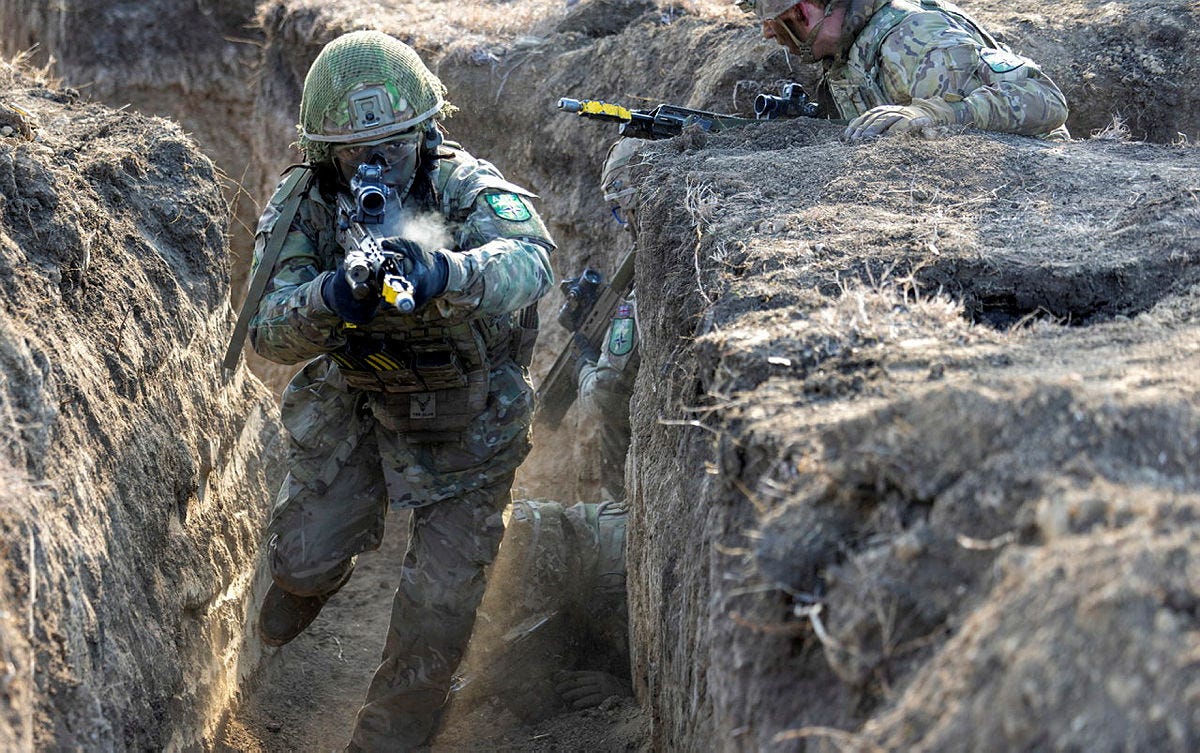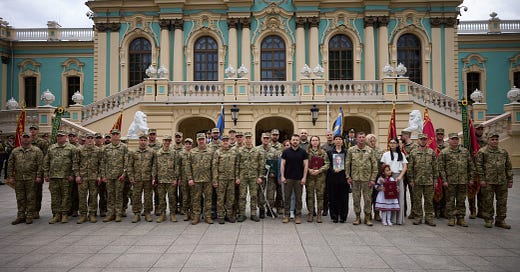Several years ago, as a very junior officer I attended a media training course. One of the instructors was a journalist, and a grizzled veteran of decades in the news business. During one of his lessons, he asked the students to complete the following fundamental statement: ‘News is….’. Despite multiple attempts (‘current affairs’, ‘interesting’, ‘fresh’) none of us came up with the correct ending. After exhausting our efforts, the instructor smiled and, in a strong Irish brogue, revealed the answer: ‘News is people’.
His point was that, regardless of context, at the heart of all great news stories – all great events – is the human element. Its all about people.
This article is about the human element in war, and how it sits at the heart of all conflict. Amongst all the discussion of technology, of industrial capacity, geopolitical shifts and the rest, conflict is a fundamentally human problem. It is people who fight wars, who win wars, who lose wars, and who suffer in wars. It is people that kill, and people who die in wars. People start wars, and people end wars. War is people, and this must never be forgotten in any discussion of conflict.
As I write this article, do not take it to mean that I am a technophobe, neo-luddite or think that technological advancement is irrelevant. Of course technology matters hugely in war – but as an enabler of human activity not in of itself. I wish to get away from the obsession with different types of drones, or whether this tank is better than this tank, or how much this particular weapon system will change the war in Ukraine. War isn’t an RTS game.1 War is people.
Fighting Power
In UK doctrine, ‘fighting power’ - the sum total of your ability to wage war - is divided into three components: the Physical, Conceptual, and Moral.
In simple terms, the Physical is the ‘what’ or the ‘stuff’ of war, the Conceptual is the ‘how’, and the Moral is the ‘why’. Out of those three, two are explicitly human-centric, and even the Physical component includes both ‘manpower’ and ‘training’.2 Through this model, you can see that the weight of fighting power is human-centric. People fight wars.
People in the Russian War Against Ukraine

Let’s discuss the Russo-Ukraine War. For both sides, the overwhelming problems have been human, not technical. This has been present since the beginning but has only really been discussed in serious detail in recent months.
Firstly, the Physical component - numbers. Even with a plethora of cheap, effective drones, neither side has enough trained, experienced soldiers to carry out their overall objectives. Many have asked why Ukraine doesn’t expand conscription to the under-25s, or why the Russians don’t make more use of their own vast conscript pool.3 The answer is human politics. This cannot be dismissed as simply being against military logic. War is a fundamentally political endeavour, and the politics cannot be ignored or waved away as inconvenient. For varying reasons, neither the Ukrainian nor the Russian governments are currently willing to make the political decision to expand forced mobilisation, and therefore have had to resort to other methods in order to find enough soldiers.4
Secondly, the Conceptual: doctrine and training. While there have been incredible military successes in the war, both sides have been hampered by training and doctrine problems. One of the best activities the UK and other allies have conducted in support of Ukraine is Operation Interflex, the basic training of Ukrainian soldiers; however initial recruit training is only one part of the puzzle. Broadly, the Ukrainian forces have proven to be incredibly innovative at the tactical level, but are often unable to exploit their tactical ingenuity for operational and strategic success, partly due to inexperienced military staffs. The Russians have ratcheted up huge losses due to their callous usage of poor-quality infantry, and despite huge numerical and technical advantage have been successfully contested in the aerial and maritime domains due to deficiencies in training and doctrine.
Finally, the Moral component. Quite simply, the war continues to being waged because Ukraine as a nation still has the will to resist, and Russia still has the will to throw thousands of its citizens into a meatgrinder for imperial conquest. The fact that the war is still being fought is a testament to the human element in war. On paper, the Russian behemoth with its overwhelming superiority in matériel and numbers should have crushed Ukraine in 2022. Three years later, despite all the horror, the brutality and the suffering, Ukraine is still fighting, testament to the sheer courage of her people.
Consequences for Europe

In light of President Trump’s questionable commitment both to Ukraine and European security more generally, there is much talk about how to rearm Europe in case it has to fight Russia alone. This understandably has focused a lot on hardware – weapons, vehicles, ammunition, drones – for which there is absolutely an urgent need.
However, as I pointed out in my article from a few weeks ago, what is often over-looked is the human element within all of this. European NATO is not used to fighting alone and has built its forces to rest on – and within – a bedrock of American power. Learning how to fight at Brigade, Division and maybe even Corps level without the United States will take years of training, experimentation and experience. Gaining the precious enablers that are predominantly provided by the US is not simply a case of buying the right equipment – it is learning how to use it from the individual practitioner all the way to the joint operational level, and maintaining that knowledge and experience. A recent excellent report from RUSI on European air power made the very clear point that most European air forces don’t dedicate enough time to training for specific combat roles, even if they do have the equipment, partly due to cost, time, and scarcity of pilots.
This is something I do worry about regarding the British Armed Forces, despite our excellent personnel. I don’t just say this out of national chauvinism – it is pretty universally considered that the overall quality of British military personnel is extremely high. However, I am concerned that we take this too much for granted, and that our ability to maximise that quality is becoming degraded as personnel are unable to train enough in more complex roles due to insufficient equipment, high operational tempo, and lack of available training areas. I still think we have an edge, but it is in danger of being eroded.
This really matters because without good people, we will lose. Conflict is chaotic, messy, and utterly bewildering – technology arguably makes it more so, not less.5 Well-trained, intelligent, motivated people will do best in such an environment, regardless of whether they are an infantryman, a staff officer, a ship captain, or piloting a drone.
The Future
Artificial Intelligence is here, and is already making an impact in the battlespace. It will undoubtedly continue to influence how we fight wars – but I can’t see it completely replacing the human element. Even with all the AI-powered weaponry, drones, and hypersonic missiles flying about in a transparent battlespace, wars will likely still boil down to human soldiers with rifles closing with the enemy, and it will be human beings – whether military or civilian – who will still ultimately suffer the effects of war.
War is a human endeavour, fought for very human, political reasons. Humans start wars, humans fight wars, and humans end wars. War is people.
Another more serious article, I admit, but I think an important one for me to write. Let me know if you have any thoughts and feelings in the comments below.
All the best,
Matthew
‘Real-time Strategy’ for those of you who don’t play video games.
I actually happen to disagree with the doctrine in that I think ‘training’ should be considered more part of the Conceptual, but I digress.
For avoidance of doubt in case it was not clear, Russia is not using its conscripts in Ukraine, but relying primarily on contracted soldiers and volunteers.
A reminder to conscription-enthusiasts that introducing mandatory military service isn’t as simple as many make it seem.
Including training for it. Anybody who has witnessed or taken part in a military exercise will know just how easily even training can ‘gang aft agley’.





An excellent and timely piece. One of the many problems with expressing defence capability of terms of percentage of GDP, is that it tends to focus on equipment and fails to recognise that the first challenge is to recruit and train people.
Great points. This reminds me of this quote: In war, moral factors acount for three quarters of the whole; relative material strength accounts for only one quarter. - Napoleon
(Unless you are out of ammunition)
This raises the question of how free societies successfully recruit and, more importantly retain, the right kind of people to build and maintain their armed forces on a multi generational scale. No nation state, even one with large active and reserve forces, can hope to succeed if it cannot do that. Moreover, serving personnel, active or reserve, have to be convinced their service is valued; that their equipment, training and support enable them to win any fight; and that they are fairly compensated.
These are not things that nations can skimp on, but time and again you see just that happening.